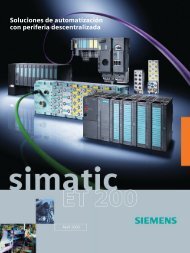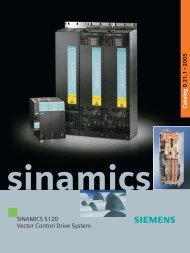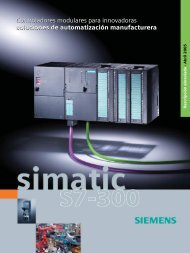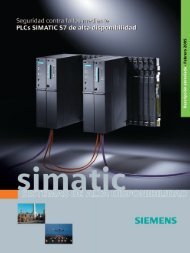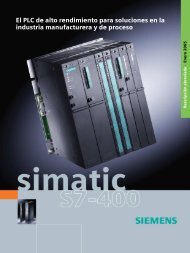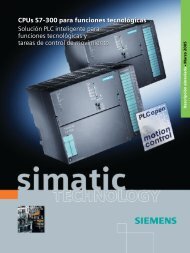Power supplies SITOP power LOGO!Power Catalog K T 10.1 2004
Power supplies SITOP power LOGO!Power Catalog K T 10.1 2004
Power supplies SITOP power LOGO!Power Catalog K T 10.1 2004
You also want an ePaper? Increase the reach of your titles
YUMPU automatically turns print PDFs into web optimized ePapers that Google loves.
<strong>SITOP</strong> <strong>power</strong> · Standard 24 V<br />
Uninterruptible <strong>power</strong> <strong>supplies</strong><br />
DC UPS module 6 A<br />
9<br />
■ Technical specifications (continued)<br />
DC UPS module 6<br />
Order No.<br />
6EP1 931-2DC21<br />
6EP1 931-2DC31 (with serial interface)<br />
6EP1 931-2DC41 (with USB interface)<br />
Signalling 1)<br />
Normal mode Green LED (OK) and floating changeover contact "24 V DC OK/Bat" to position "24 V DC OK" 2)<br />
Buffer or battery mode (battery <strong>supplies</strong> Yellow LED (Bat) and floating changeover contact "24 V DC OK/Bat" to position "Bat" (= de-energized<br />
load on its own, or in addition to PS in position)<br />
event of overload)<br />
Alarm (buffer readiness missing or prewarning<br />
at < 20.4 V battery voltage)<br />
"Battery replacement necessary"<br />
"Battery charge > 85 %"<br />
Optional interface and software<br />
Serial interface<br />
USB interface<br />
Software<br />
Control signals<br />
On/off control signal<br />
"Remote timer start" via serial interface or<br />
USB<br />
Safety<br />
Galvanic isolation primary/secondary<br />
Protective class<br />
EMC<br />
Interference emission<br />
Red LED (Alarm) and floating changeover contact to position "Alarm" (= de-energized position).<br />
Causes for absence of buffer readiness during normal mode could be: Operating status Off or open on/off<br />
control circuit, battery module not connected, battery faulty or with reversed polarity (battery voltage<br />
< 18.5 V) or wire breakage between battery and UPS module. Scanning and thus updating of the signal<br />
every 20 s.<br />
Causes for absence of buffer readiness during buffer mode could be: Battery voltage has fallen below<br />
20.4 V DC (= prewarning prior to switching-off by exhaustive discharge protection) as well as switchingoff<br />
of battery because of overload, short-circuit, exhaustive discharge protection or expired buffer time.<br />
The Red LED then goes off.<br />
Red LED (Alarm) flashes at 0.25 Hz and floating changeover contact (Alarm) switches at approx. 0.25 Hz<br />
Green LED (Bat > 85 %) and floating NO contact closed (de-energized position = open)<br />
Only with 6EP1 931-2DC31<br />
Output of all signals, and receipt of signal "Remote timer start".<br />
Techn. design: PC-compatible. 8N1 send and receive, 9600 baud, 8 data bits, 1 stop bit, no parity bit.<br />
Required connection to PC: 1 : 1 continuous 9-pole SUB D extension cable (male/female),<br />
only pin 2 (RXD), pin 3 (TDX) and pin 7 (RTS) are required.<br />
Only with 6EP1 931-2DC41<br />
Output of all signals, and receipt of signal "Remote timer start".<br />
Techn. design: Specification 2.0 with full speed, i.e. 2 Mbit/s. <strong>Power</strong>ed by DC UPS with +5 V<br />
("self <strong>power</strong>ed").<br />
Required connection to PC: Commercially available 4-core shielded cable, 90 Ohm, max. 5 m,<br />
USB series "A" connector to PC and USB series "B" connector to DC UPS<br />
A software tool (executes under WinNT4.0, Win 2000 and WinXP) for reading and processing the signals<br />
is available on the Internet at http://www.siemens.de/sitop<br />
as a download. Further information on the interface can also be found there.<br />
By opening the control circuit (or using DIP switch on device), the buffer mode is terminated, or the<br />
battery is disconnected from the output. All other functions are retained.<br />
Starts the mains buffering for the set buffer time<br />
No<br />
Class III (ext. circuit and <strong>power</strong> supply unit: SELV voltage acc. to EN 60950 is required)<br />
RI suppression acc. to EN 55022, limit characteristic B<br />
Interference immunity Interference immunity acc. to EN 61000-6-2<br />
Ambient conditions<br />
Ambient temperature during operation 0 to +60 °C with natural convection<br />
Transportation and storage temperature -40 to +70 °C<br />
Degree of protection (EN 60529) IP20<br />
Humidity rating<br />
Conditions of use acc. to EN 60721, climatic class 3K3 (relative humidity 5 % to 85 % and absolute<br />
humidity 1 g/m³ to 25 g/m³; no condensation)<br />
Approvals<br />
CE<br />
CE conformity acc. to 98/336 EEC and 73/23 EEC<br />
UL / cUL<br />
UL 508 / CSA C22.2, File E197259<br />
Mechanical specifications<br />
Connections for 24 V DC input<br />
2 screw-type terminals for 1 to 4 mm²/17 to 11 AWG<br />
Connections for 24 V DC output<br />
4 screw-type terminals for 1 to 4 mm²/17 to 11 AWG<br />
Connections for 24 V DC battery module 2 screw-type terminals for 1 to 4 mm²/17 to 11 AWG<br />
Connections for control circuit and signals 10 screw-type terminals for 0.5 to 2.5 mm²/20 to 13 AWG<br />
Dimensions (W x H x D) in mm 50 x 125 x approx. 125<br />
Required clearance<br />
50 mm above and 50 mm below the device<br />
Weight<br />
Approx. 0.4 kg (with serial or USB interface: approx. 0.45 kg)<br />
Mounting<br />
Snap-mounting on DIN rail EN 50022-35x15/7.5<br />
1) Permissible contact rating: 60 V DC/1 A or 30 V AC/1 A. 2) "24 V DC OK" means: Voltage of <strong>power</strong> supply unit is greater than the<br />
battery connection threshold set on the DC UPS module 6.<br />
9/8<br />
Siemens KT<strong>10.1</strong> · <strong>2004</strong>




